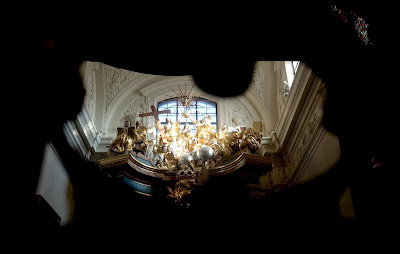Sunday, December 2, 2018
Dec. 2, 2018: St. Bridget's Church in Gdansk
This is a tree hugger's dream. An altar made almost entirely of amber. Not only is it warm, light, and beautiful in an otherwise dark church, but it comes from trees. How wonderful is that?
St. Bridget's church in Gdansk was so named when the remains of St. Bridget of Sweden were stuck in transit in Gdansk in 1394 and housed in a small chapel where the church now stands. During the long transit time, a number of miracles came to pass for those who touched St. Bridget's casket and a church was then built to host St. Bridget's order.
Like most other buildings in Gdansk, St. Bridget's church was almost entirely destroyed during World War II. It was rebuilt in 1973 based on original designs and drawings.
Saturday, December 1, 2018
Dec. 1, 2018: The Great Palm Tree of Warsaw
Joanna Rajkowska is the one responsible for this <fill in the blank with any number of sometimes unflattering adjectives> monument at the intersection of Nowy Świat and Al. Jerozolimskie in downtown Warsaw. Only the heavily inebriated would ponder whether this mammoth palm tree is real or artificial for more than a few nanoseconds. For those of us who saw it sober, however, we have to wonder why there is a great fake palm tree standing in the middle of an intersection in this anything-but-tropical city. Constructed in California and made of an odd trio of bendable steel (so the palm can wave in the wind like the real deal), natural bark, and plastic leaves, the tree was conceived and brought to fruition by the artist in order to bring relief to a dreary Warsaw winter.
And, when not surprisingly, some protested the tree as an eyesore to be removed as quickly and completely as possible, the protesters emerged from their homes, clad in bikinis and armed with margaritas, to sit under the tree and guarantee that it remain in its place for many years to come.
Which side will you choose? Keep the Tree? Axe it?
The debate continues.
Dec. 1, 2018: Old Town Warsaw
To the right, a bronze statue of King Waza sits on top of a 72 foot high Corinthian column to celebrate the move of the Polish capital from Krakow to Warsaw in the late 1500's. At the time that it was built, the monument was the grandest in Europe but today, it is eclipsed by a mere Christmas tree.
Times certainly do change. I wonder if King Waza is rolling over in his crypt over the whole state of affairs.
Dec. 1, 2018: St. John's Archcathedral in Warsaw
On a cold, sunny day in modern Warsaw, it seems hard to believe that the 1945 Warsaw Uprising ever happened. It seems hard to believe that an army drove a tank into this church and blew it up along with any Poles taking harbor inside. It seems hard to believe that this massacre wasn't enough.
A few days later, someone found it necessary to come back, diligently drill holes, methodically plant charges, and joyfully destroy the last of the walls left standing of this once beautiful church.
When the Polish resistance rose up in 1945 against Nazi occupation, they did so in anticipation that the Red (Soviet) army laying in wait just across the Vistula river from Warsaw, would help them. And if not them, someone, somewhere would come to their aid. But, despite appeals from Winston Churchill, only the British attempted to help and ultimately, without success. Thousands of Polish resistance fighters died and over a hundred thousand Poles were executed in the Uprising. After which, aided by German engineers, the German army systematically, maliciously, and without rational reason, destroyed building after building, until almost nothing was left standing in the aftermath of the war.
Certainly, the Poles thought to rebuild the capital of Poland elsewhere, to begin anew somewhere else. But, they didn't. They rebuilt Warsaw, one step at a time, one reconstruction project after another. That's a resilience I am not sure I have in me. I am not sure the U.S. does either.
The contrast between the darkness that lay over this city during World War II and the life that it exudes today is hard to stomach. One could hope that the world will never see evil proliferate and overshadow good to the extent that it did during the Warsaw Uprising, the Holocaust, and other unspeakable tragedies of WWII.
But, such hope has, is, and will be dashed over and over again.
To what end?
Subscribe to:
Comments (Atom)








